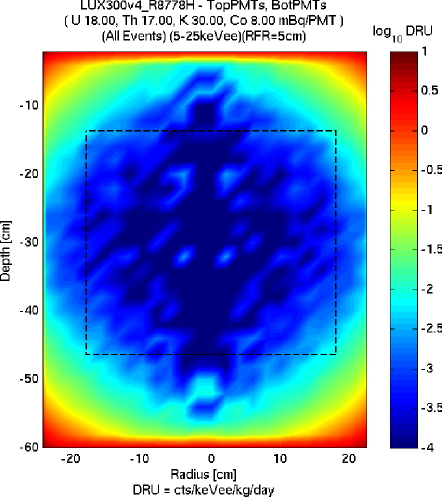When the size of dark-matter detectors increases, so does the need for a more sophisticated trigger. The LUX trigger electronics utilizes both the S1 and S2 signals to make a trigger decision. By connecting the analog sum of groups of individual PMTs to the input channels of the trigger system, detailed geometrical information is preserved and can be used to make the trigger decision.
The signals associated with dark-matter events consist of two pulses: a) prompt scintillation photons (the S1 pulse) which for our dark-matter physics region of interest will result in 1-40 photoelectrons (phe) over a time-window no larger than 200 ns and b) secondary photo-luminescence photons (the S2 pulse) which will contain about 200 times the number of phe than the corresponding S1 pulse and have a typical width of ~1 ms. Depending on the depth from which the electrons have to drift, the S2 pulse(s) can occur up to 300 ms after the S1 pulse. Background events which scatter more than once in the LXe will have more than one S2 pulse and can be identified if the time difference between the S2 pulses is larger than ~1 ms, which corresponds to a z-distance of ~2 mm. An additional cut on events for which multiple vertices occur at the same z-depth can be performed using the S2 hit pattern.
The LUX trigger electronics is designed to handle two primary modes of operation. In the dark-matter search mode, the LUX trigger must be able to differentiate S1 and S2 signals and use the geometrical information provided by the PMT locations and the time difference between the S1 and S2 signals to trigger on dark-matter candidate events that occur in the fiducial volume of the detector. In calibration mode, the LUX trigger must select those classes of events that have interactions in the fiducial volume of the detector, since these are most useful for calibration purposes. Calibration of dark-matter experiments with g-ray and neutron sources is critical in order to ensure that the detailed detector response (e.g. signal variation with position) is well understood. In particular, sufficient statistics must be collected at a level that allows the identification of any “tails” in the response functions that would lead to the misidentification of background events as WIMP signals. Given that calibration data sets will be 10 to 100 times larger than the data collected during the dark-matter search mode, an intelligent trigger will ensure that gamma-ray and neutron source calibrations do not to eat into the real time operation of LUX.
The importance of a sophisticated trigger for dark-matter detectors is often not fully appreciated. The goal of the trigger is to enhance the quality of the data collected during both dark-matter operation and detector calibrations. The expected electron-recoil background in LUX due to the activity of the photomultiplier tubes is shown in the Figure as function of position. Although the background rate in the fiducial volume, outlined by the dashed rectangle in the Figure, is less than 10^-3 counts/keVee/kg/day, the background rates in the regions outside the fiducial volume are 10^3 - 10^4 times higher. Without the ability to trigger on events that occur in the fiducial volume of the detector, 99.9% of the data acquired will be of no interest. During calibration runs, the data collection rate is limited by the bandwidth of the DAQ. By increasing the quality of the data collected, the number of events that can be used to define the background in the nuclear recoil region increases, and the uncertainty in this background decreases. The LUX trigger electronics is the result of years of development by Dr. Skulski from SkuTek which started with the single-channel FPGA-based digital signal processor, the DDC-1, and resulted in the production of the DDC-8DSP, an eight-channel FPGA-based digital signal processor. The LUX trigger uses the DDC-8DSP to trigger LUX. You can use the following links to learn more about the various signal processors that have been developed by Dr. Skulski: |
 |
Last updated on Wednesday, October 1, 2008 9:39